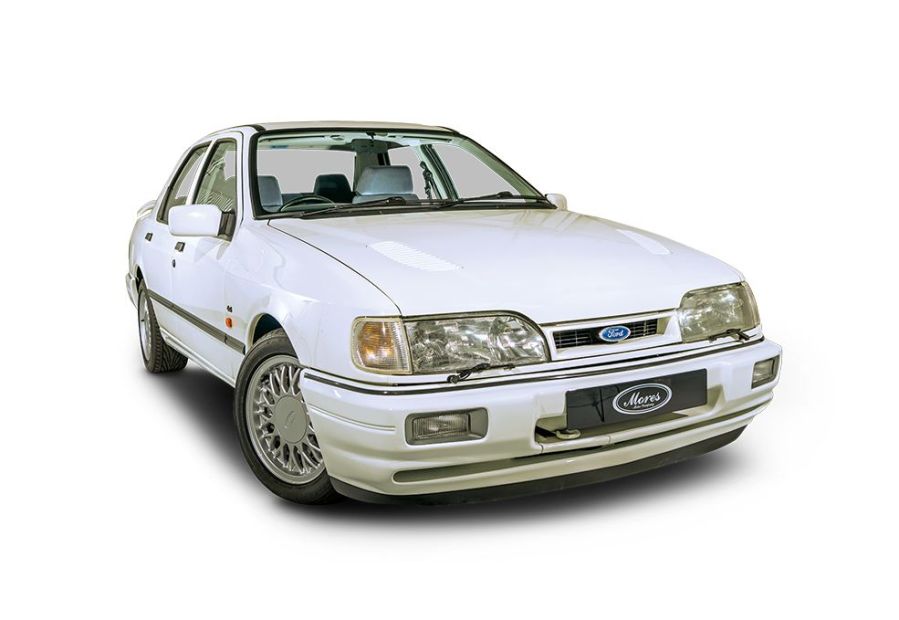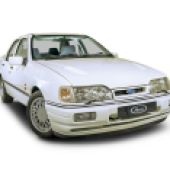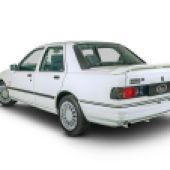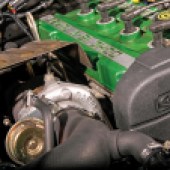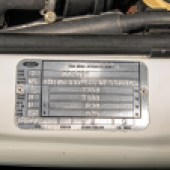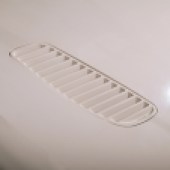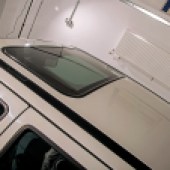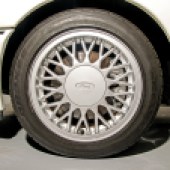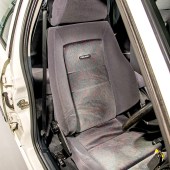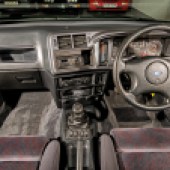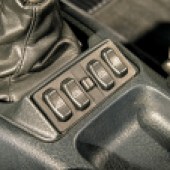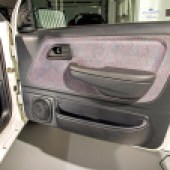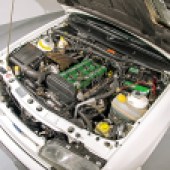It’s a YB’d Sierra that won’t try to kill you on every journey; the Ford Sierra Sapphire Cosworth 4×4 has shed its taxi image to become the cheapest, most usable – and oh-so-tuneable – Cossie of all. Here’s how to buy a good one.
Ford Sierra Sapphire Cosworth 4×4 history
- January 1988 – Sierra Sapphire RS Cosworth introduced with rear-wheel drive, 204bhp YBB engine (205 block), T5 gearbox, 7x15in lattice alloy wheels, four-door bodywork, front and rear spoilers, side skirts and Recaro seats.
- January 1990 – Sierra Sapphire RS Cosworth 4×4 launched, based closely on the previous Sapphire Cosworth but with stronger cylinder block (200), revised head, bigger intercooler and 220bhp. Now with Sierra XR4x4-type viscous-coupled four-wheel-drive system and MT75 gearbox, floating front brake callipers, ventilated rear discs, clear front indicators, smoked rear lights, vented bonnet and 4×4 badges. Recaro seats standard in Raven/Halley cloth or optional Raven leather.
- August 1991 – Facelifted 4×4 with shark-tooth alloy wheels, modernised dashboard, Space cloth upholstery, electric sunroof and catalytic converter.
- March 1992 – Soft-feel four-spoke plastic steering wheel replaces leather.
- December 1992 – Sapphire Cosworth production ends. Final cars receive single-colour rear spoiler without painted black lip. Around 12,250 produced in total, all at Genk, Belgium.
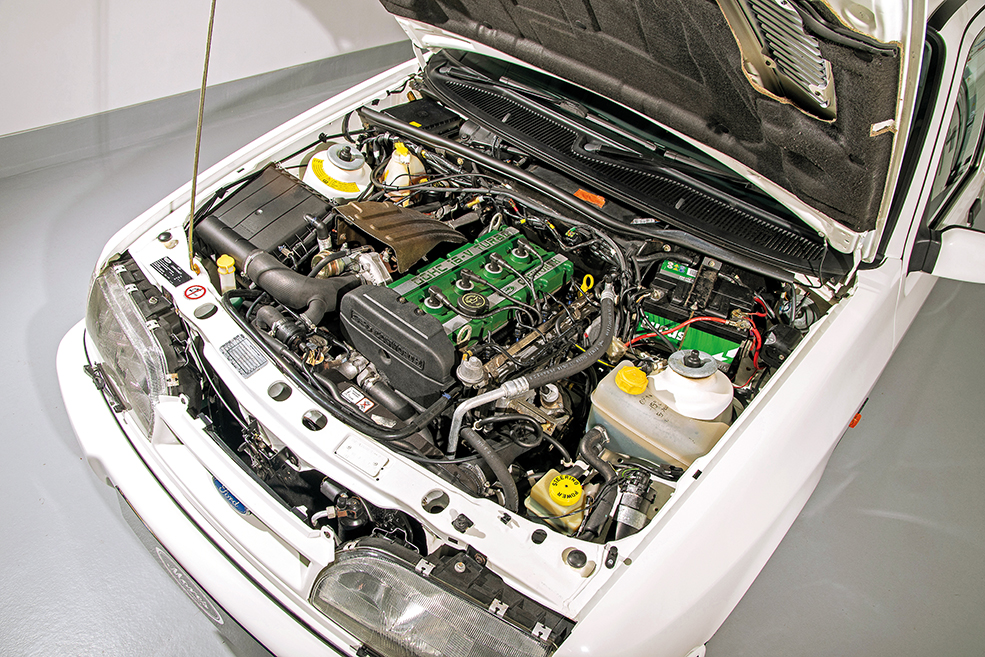
Engine & Transmission
If you’re reading this, the YB needs no introduction: it’s a world-class motor, it’s capable of huge power, and it costs a bomb to put right when it breaks. And it does break.
First, make sure a Ford Sierra Sapphire Cosworth 4×4 has the proper (stronger) YBJ/YBG engine – the block should have ‘200’ cast into the side in large digits, and certainly not ‘205’. Until August 1991 it had a red cam cover; afterwards a green cam cover and catalytic converters.
Listen for nasty noises from cold. Knocking, growling or tapping from the bottom end suggests a worn crank or bearings, knackered pistons or scored bores. Very bad news.
Smoking may be equally serious. Plumes of black soot under throttle mean it’s running rich, blue smoke points to worn pistons/rings or tired turbo (wiggle the compressor wheel to check for play), and white clouds suggest head gasket failure or damaged cylinder head – look out for water in the oil or external coolant leaking down the block.
Poor performance could have a sinister or simple cause, but may need extensive diagnostics. Boost problems may result from split or loose hoses, sensors and regulators. Misfires under load are often due to spark plugs, leads or coil – but could be more serious.
Bad wiring, poor connections and chafed cables can lead to slow-starting, misfires and breakdowns. Cooling fan wiring tends to melt, so check the fans cut in when the engine is warm. A new engine loom isn’t cheap but could be worth every penny.
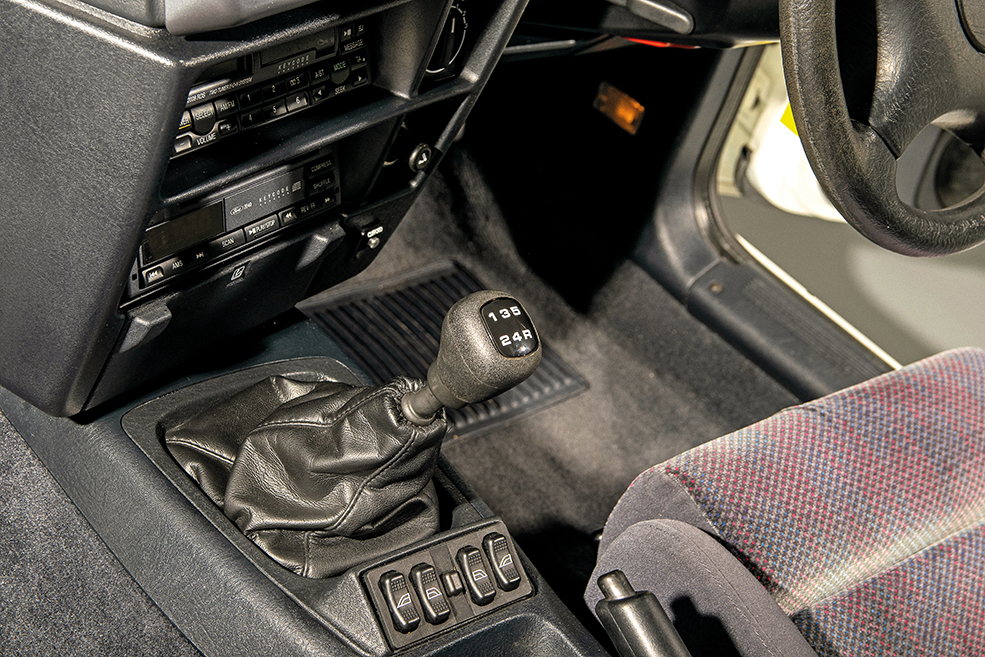
Inspect the fuel pump, filter and cradle (beneath the boot floor). If they’re grotty and corroded, account for getting them replaced. A pump that’s not getting 13 volts could cause underfuelling severe enough to kill the engine.
Unless you’re seeking a museum piece, don’t be dissuaded by a modified Sapphire. The 4×4 needs at least Stage 1 upgrades (chip, exhaust and -31 actuator) to feel lively. On the flip side a big-power Cossie could be a ticking time bomb, so ask to see receipts from a tuner – ideally a Cosworth specialist.
The Ford Sierra Sapphire Cosworth 4×4 layout is its strength but it’s also its weakness. The four-wheel-drive Sapphire offers great grip but the transmission system can be fragile – especially when asked to cope with 350bhp-plus of modified YB. A thorough inspection is vital.
Ensure the gearchange is firm and precise. If there’s crunching or difficulty engaging gears – especially on the down-change – worn synchromesh rings are probable, meaning the MT75 needs a rebuild.
Nasty noises don’t bode well. A whining gearbox is on its last legs, and rattling at idle (sounds similar to clutch bearing vibration) suggests the layshaft bearings are tired. Clonking or snatching driveshafts point to centre differential failure; vibrations could be from broken propshaft joints or engine/gearbox mounts; loud clicking is probably a knackered CV joint.
Clutch slip is easy to spot: floor the throttle at 3000rpm in fifth gear and ensure the car speeds up as the revs increase. A stiff pedal is probably just a sticky cable.
Beware of a 4×4 running only in rear-wheel drive – fine if done properly using a T5 gearbox, but not if it’s due to a broken centre diff.
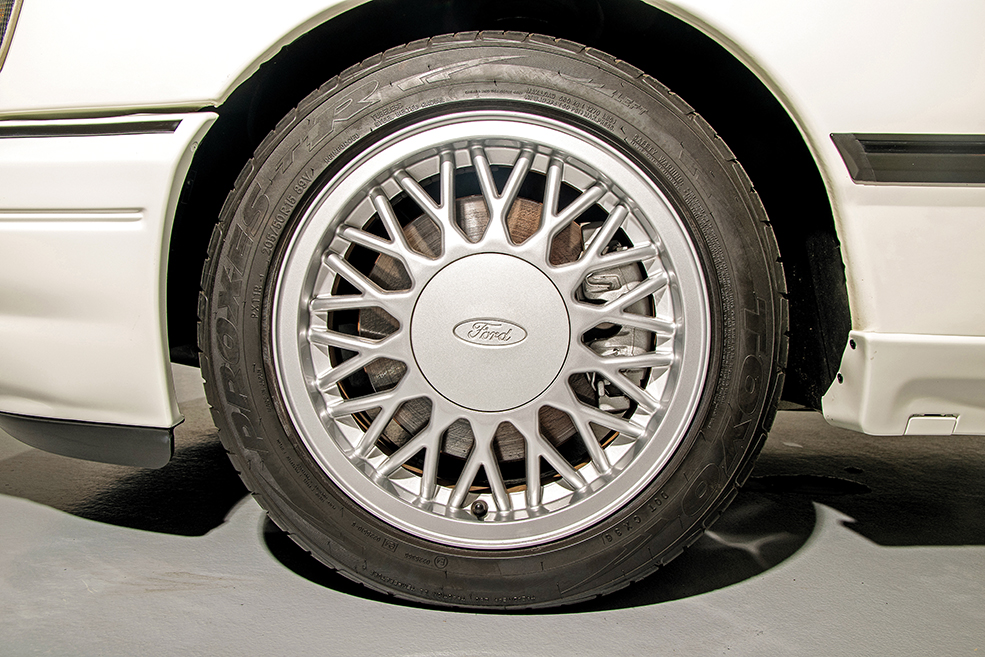
Chassis
A stock Ford Sierra Sapphire Cosworth 4×4 feels stodgy and lifeless compared with a rear-wheel-drive Cossie. Factor in three decades’ wear, and it won’t be much fun.
Chief culprits for poor handling are tired suspension bushes: worn track control arm bushes cause wandering from the front end; trailing arm bushes result in sloppiness at the back. Powerflex polyurethane replacements are the simple and permanent solution.
Vagueness at speed could also come from the steering. Knackered steering column bushes cause a lack of feel, and the Sapphire is prone to looseness at the steering rack, so jack up the car and feel for play. Check for oil leaks from split gaiters, and make sure the PAS pump isn’t noisy.
Bushes can cause clonking noises, but check for broken coil springs or tired dampers. It’s normal for Sapphires to be on aftermarket suspension, which generally improves handling, but coilovers are too stiff for a road car, and a drop greater than 25mm risks damaging the CV joints.
Sapphire 4x4s lacked the four-pot callipers of their predecessors – instead fitted with Scorpio-type floating callipers – but at least the rear discs were ventilated. The pedal should be firm and communicative, and with decent fast-road pads the stopping power is acceptable. But compared to a modern machine, a Cosworth with duff brakes will feel lousy and downright dangerous.
Juddering felt through the brake pedal and steering wheel is typical of contaminated discs and/or pads, although it’s worth checking broken suspension components aren’t at fault. Pulling to one side under braking suggests a sticking front calliper; seized rears are particularly common, especially on the handbrake mechanism; jack up the car and check with it in the on or off position.
Cosworths used a decent Teves ABS setup, which commonly causes problems from dirty/faulty wheel sensors or broken wiring. A failed ABS pump, blown fuses and fluid level sensors could also be to blame.
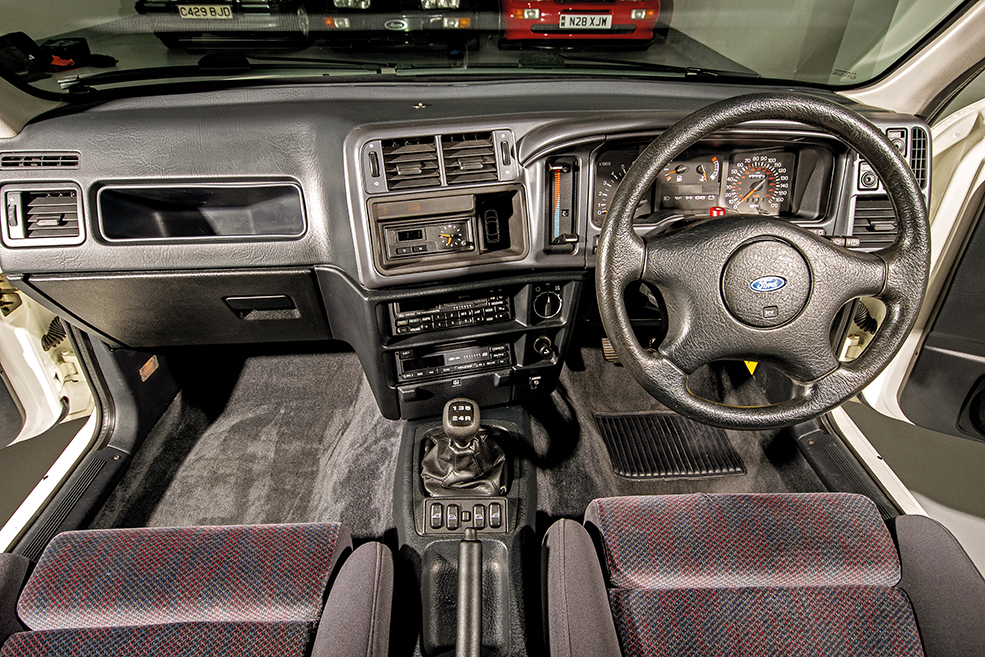
Interior
A Cossie with a tatty cabin tells you it’s led a hard life. It also says you’ll be spending cash to get it back up to scratch – so it pays to find a Sapphire with a mint interior.
Check is the driver’s seat, which will show wear on wear on the bolsters, collapsed foam, a broken base or floppy recliner mechanism. A typical trick is to replace it with a better seat from the passenger side. Leather trim is more common than cloth, but don’t pay a premium for either. Early Sapphire 4x4s had the same dark grey upholstery as late RWDs; from August 1991 it was swapped for so-called Rainbow cloth, which is rare if not exactly desirable.
Cars of this age also had a curvier dashboard. Thankfully, a Sapphire dash doesn’t crack like that of a three-door Cosworth, but check it isn’t damaged or distorted. Rattling and creaking is all part of the old-school-Ford charm. Leather on the gearknob and steering wheel may be worn; late cars had a horrible four-spoke plastic wheel.
Door cards tend to have vinyl lifting from the backing where it meets the glass; good replacements are hard to find. It’s normal to see a headlining dirty or drooping, especially in the rear passenger compartment, or stained around the sunroof if it’s been leaking. Reconditioned headlinings are readily available.
Talking of sunroofs, check it for rot. A post-August 1991 Sapphire should have an electric version, so ensure it works. Central locking and electric window motors also have a habit of seizing, but they’re the same as ordinary Sierra parts, so can still be sourced for sensible money.
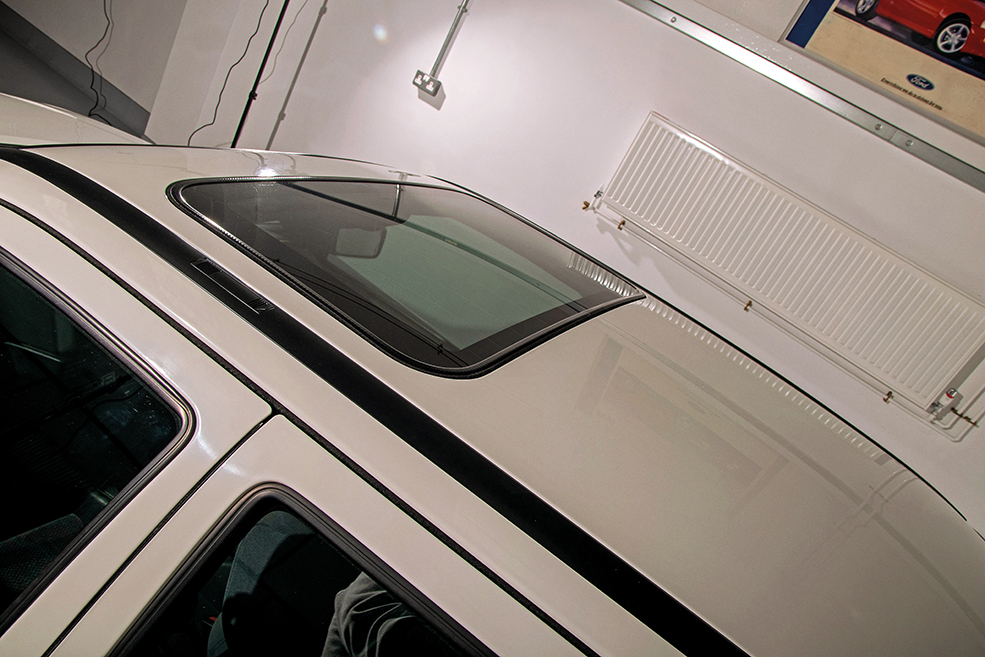
Ford Sierra Sapphire Cosworth 4×4 exterior
Corrosion has killed thousands of Sapphire Cosworths – so inspect your potential purchase particularly carefully.
Begin beneath the bonnet (which on a 4×4 should feature factory-fitted vent cutouts). Inner wings are susceptible to rot, especially beneath the header tank and around the suspension turrets, which in severe cases can collapse. Bulkhead rust is also serious, so look around the battery tray and under the fuse box.
Inspect the front crossmember and chassis rails; a genuine 4×4 should have Ford-produced half-moon recesses for the driveshafts, so walk away from anything that looks home-made.
Examine the entire underside – especially the rear chassis box sections beside the spring seats, along with the floorpans and sills. Sunroof leaks can play havoc.
The doors, front wings, inner and outer wheelarches, boot floor and boot lid may be rusty, but most body panels are shared with regular Sapphires, so they’re not too pricey. Vented 4×4 bonnets are becoming expensive, as are the front bumper and side skirts, which are prone to sagging. Check the front grille doesn’t have snapped lugs, and ensure the back bumper isn’t wonky because undamaged replacements are rare.
Don’t forget Cosworths were well-known for being crashed, so watch out for accident damage, such as creases in the floorpan (don’t worry too much about flattened jacking points), inner wings and boot floor, bad panel gaps and poor paintwork.
Some rarer colours – such as Radiant Red – carry a small premium, but unless you’re set on a particular colour, buy on bodywork condition alone.
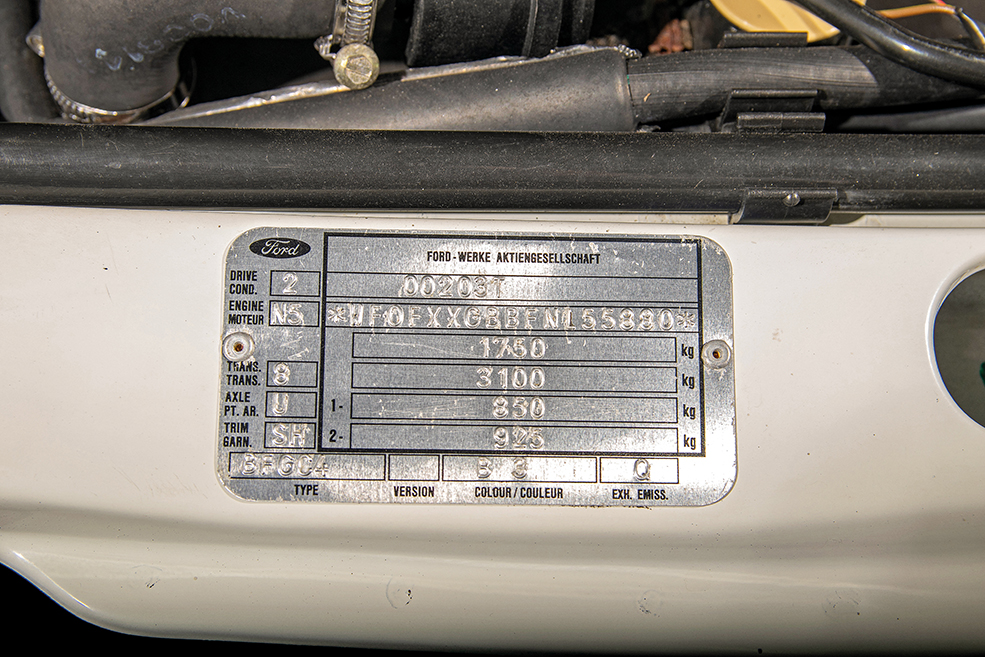
Identity
Cossies are notorious for being nicked, crashed and faked, so it’s crucial to invest in a full history check – and not a cheap phone app.
Inspect the chassis number: you’ll find it on the VIN plate (riveted to the bonnet slam panel) and stamped into the floor beneath a carpet flap beside the driver’s seat. It should match the digits on the V5 log book, reading WFOFXXGBBF followed by two letters (for the build date) and five numbers, which reflect the engine number. Remember, a 4×4 should have a cylinder block with large ‘200’ casting numbers on the crankcase.
Other digits on the VIN plate should read N5 for engine code, B (right-hand drive) for drive, 8 for trans, U for axle, and BFGC4 in the type box.
Ensure the car you’re inspecting matches the year, colour and spec it’s claiming to be. All 4x4s had a vented bonnet, clear front indicators and tinted rear light lenses; a right-hand-drive road-car shell should have a factory-pressed cutout behind the brake servo, straight towing eye, glass sunroof, and driveshaft cutouts in the chassis rails.
Fakes and replicas are surprisingly common, worth considerably less than original Cosworths.
Run away from any Cossie with a dubious past. If it’s too cheap to be true, don’t be surprised to see a ground-off chassis number and a mishmash of stolen parts.
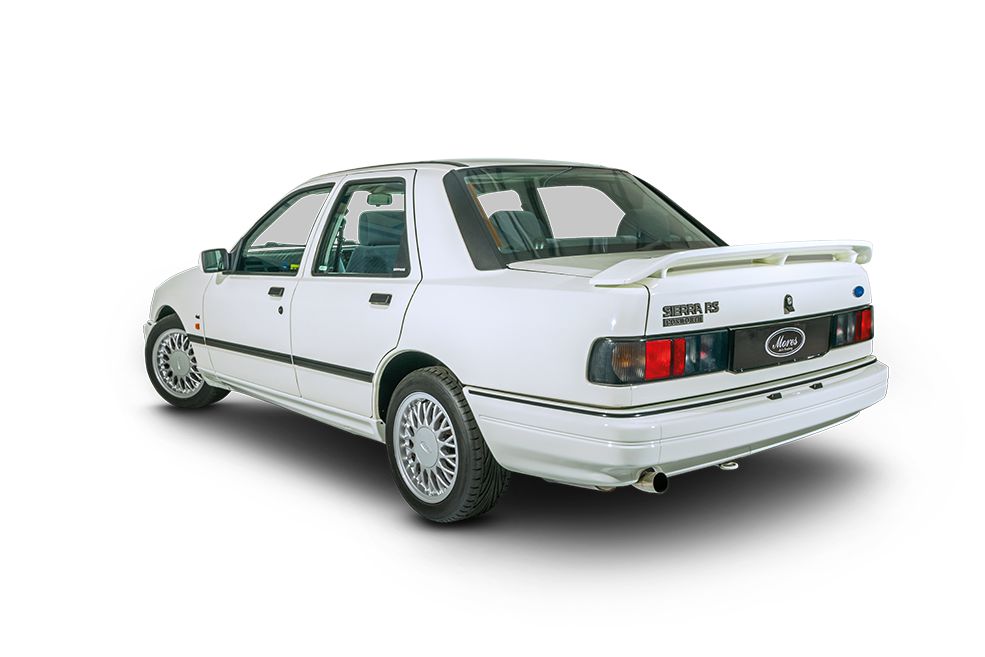
Guide from Fast Ford. Words: Dan Williamson. Photos: Jamie King
Tech Spec: Ford Sierra Sapphire Cosworth 4×4
Engine:
1993cc four-cylinder, 16V, DOHC Ford Cosworth YBG/YBJ with cast iron 200 block and alloy cylinder head, 8.0:1 compression ratio, toothed belt drive, Weber-Marelli multi-point fuel injection and electronic management system, Garrett T03 turbocharger with intercooler
Transmission:
Four-wheel drive with MT75 five-speed manual gearbox, viscous coupling front and limited-slip viscous coupling rear differentials, 34/66 per cent front/rear split, 242mm clutch. Final drive ratio: 3.62:1
Suspension:
Front: MacPherson struts, gas-filled dampers, coil springs, lower track control arms, 28mm anti-roll bar; rear: independent, semi-trailing arms, coil springs, gas-filled dampers, 18mm anti-roll bar
Brakes:
Front: 278mm ventilated discs; rear: 273mm ventilated discs; Teves ABS
Wheels & tyres:
7Jx15in RS alloys and Bridgestone ER90 205/50 ZR15 tyres
Exterior:
Sierra Sapphire four-door saloon with colour-coded bodykit comprising deep front bumper with fog lamps, side skirts and rear spoiler, bonnet vents, colour-coded mirrors, electric front and rear windows, tilting/sliding glass sunroof (electrically operated from August 1991). Colours: Diamond White, Magenta, Moonstone Blue, Flint Grey, Ebony Black (metallic), Black (gloss), Moondust Silver, Smokestone Blue, Nouveau Red, Radiant Red, Pacifica Blue and Mallard Green
Interior:
Ghia-level with Recaro front seats in Halley (until August 1991) or Space (from August 1991) fabric trim (Raven leather optional), three-spoke leather-covered steering wheel (four-spoke plastic from March 1992), adjustable steering column, 170mph speedometer, leather-covered gearknob, optional air conditioning

